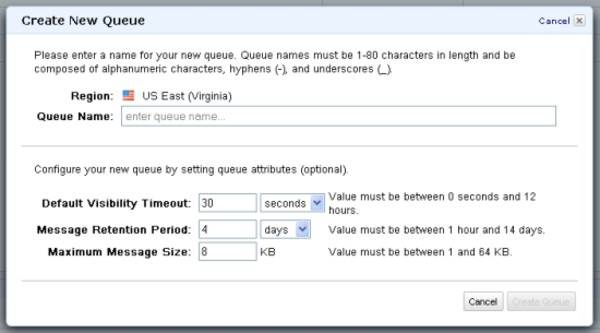The XML-based language that the Web uses for sending small transactional messages and chunks of data between hosts is Web Services Description Language (WSDL). Essentially, it’s a system for Web services to communicate almost anything between one another, first by defining the format of what it is they’re communicating – a kind of manifest – and then by enclosing instances of the items defined inside XML tags.

What makes WSDL perfect for cloud services is that the message transport protocol is simple HTTP (thus the “W” for “Web” in its name). So hosts don’t have to be joined together in the same network loop; it’s the Internet that connects them. Cloud-based Web services geared to receive WSDL messages use their own message queues, often using the same MQ systems devised for middleware. For Amazon Web Services, the MQ is Simple Queue Service (SQS). Believe it or not, up until a few days ago, AWS customers could not access their SQS queues through the AWS Management Console.
Indeed, an independent developer named Kresimir Popovic had made his own SQS management tool, and AWS support personnel were suggested that customers download and use it.
This week, Amazon’s AWS team announced on its blog that this little omission has finally been patched. The current version of AWS Management Console, deployed now, includes a complete set of tools for SQS queue management.

[screenshot courtesy Amazon Web Services]
As is typical for WSDL, messages are limited to 64K maximum size, so SQS is not an appropriate system for exchanging e-mail-sized messages. Instead, say you have an order processing system. Most likely, all the characters needed to represent the customer sign-up data can be compressed into one message. Streams of messages can then be directed to your SQS queue, where they’ll wait for up to four days (more than enough time) for your service to get around to them.
With the new AWS Console features, you can create new queues, grant permissions to them with respect to whether their handlers can send or delete messages therein, send messages to queues manually, adjust the timeout period for waiting messages, and most importantly, look inside your queues to see what’s waiting. “As you can see, this addition to the console provides you with a lot of insight into your SQS message queues, and it also provides you with a lot of control,” writes Amazon’s Jeff Barr.
Amazon Web Services was founded in 2002.

















